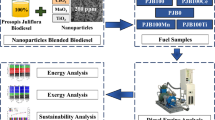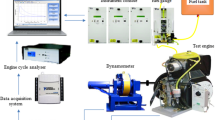Abstract
This paper investigates the effects of Hydrotreated vegetable oil (HVO)-diesel blends on combustion characteristics under various ambient oxygen concentrations and ambient temperatures in a constant volume combustion chamber (CVCC). Combustion characteristics were presented in terms of heat release rate, ignition delay and integral heat release. The shadowgraph images of spray combustion were presented for spray development and combustion progress. The experiment was carried out on CVCC under constant injection pressure and energizing time. The synthetic gas with varied oxygen concentrations between three discrete values from 21, 15 and 10 % to simulate EGR on engine conditions. The ambient temperatures were varied at 1100, 900 and 700 K to study the effects of ambient temperatures. Four different fuels were tested: commercial diesel, commercial diesel-HVO blends and HVO with the single-hole injector. The results showed that decreasing ambient oxygen concentration to 10 % resulted in 13.42 % lower heat release rate and 13.89 % lower integral heat release. This also extended ignition delay. Decreasing ambient temperature resulted in longer ignition delay with higher peak heat release rate. Increasing HVO showed 6.43 % shorter ignition delay compare to diesel due to higher cetane number. The shadowgraph images showed that HVO has better evaporation 0.7 to 0.9 ms after injection due to its lower density, viscosity and distillation temperature at T90.
Similar content being viewed by others
Abbreviations
- dQ/dt :
-
heat release rate, J/ms
- γ :
-
specific heat ratio
- P :
-
chamber pressure, Pa
- V :
-
chamber volume, m3
- dV/dt :
-
rate of volume change in chamber, m3/ms
- dP/dt :
-
rate of pressure change in chamber, Pa/ms
References
Aatola, H., Larmi, M., Sarjovaara, T. and Mikkonen, S. (2008). Hydrotreated vegetable oil (HVO) as a renewable diesel fuel: Trade-off between NOx, particulate emission, and fuel consumption of a heavy duty engine. SAE Paper No. 2008-01-2500.
Alriksson, M. and Denbratt, I. (2006). Low temperature combustion in a heavy duty diesel engine using high levels of EGR. SAE Paper No. 2006-01-0075.
Azimov, U. B., Roziboyev, E. A., Kim, K. S., Jeong, D. S., Lee, Y. G. and Yun, J. E. (2008). Investigation of soot formation in Diesel-GTL fuel blends under quiescent conditions. Int. J. Automotive Technology 9, 5, 523–534.
Azimov, U. B., Kim, K. S., Jeong, D. S. and Lee, Y. G. (2009). Evaluation of low-temperature diesel combustion regimes with n-Heptane fuel in a constant-volume chamber. Int. J. Automotive Technology 10, 3, 265–276.
Benajes, J., Molina, S., Novella, R. and Amorim, R. (2010). Study on low temperature combustion for light-duty diesel engines. Energy & Fuels 24, 1, 355–364.
Bi, X., Liu, H., Huo, M., Shen, C., Qiao, X. and Lee, F. C. (2014). Experimental and numerical study on soot formation and oxidation by using diesel fuel in constant volume chamber with various ambient oxygen concentrations. Energy Conversion and Management, 84, 152–163.
Brijesh, P. and Sreedhara, S. (2013). Exhaust emissions and its control methods in compression ignition engines: A review. Int. J. Automotive Technology 14, 2, 195–206.
Caprotti, R., Tang, T., Ishibe, N., In-ochanon, R., Tipdecho, C. and Silapakampeerapap, S. (2011). Performance of diesel containing bio-hydrogenated component. SAE Paper No. 2011-01-1953.
Chau, V. T., Chinda, C., Preechar, K., Sato, S. and Kosaka, H. (2017). Optical study on combustion characteristics of hydrotreated vegetable oil and blends under simulated CI engine conditions and various EGR. J. Mechanical Science and Technology 31, 9, 4521–4531.
Dernotte, J., Hespel, C., Foucher, F., Houillé, S. and Mounaïm-Rousselle, C. (2012). Influence of physical fuel properties on the injection rate in a diesel injector. Fuel, 96, 153–160.
Ewphun, P.-P., Vo, C. T., Srichai, P., Charoenphonphanich, C., Sato, S. and Kosaka, H. (2017). Combustion characteristics of hydrotreated vegetable oil - Diesel blend under EGR and supercharged conditions. Int. J. Automotive Technology 18, 4, 643–652.
Hartikka, T., Kuronen, M. and Kiiski, U. (2012). Technical performance of HVO (hydrotreated vegetable oil) in diesel engines. SAE Paper No. 2012-01-1585.
Heywood, J. B. (1988). Internal Combustion Engine Fundamentals. 2nd edn. McGraw-Hill. New York, USA.
Imtenan, S., Varman, M., Masjuki, H. H., Kalam, M. A., Sajjad, H., Arbab, M. I. and Rizwanul Fattah, I. M. (2014). Impact of low temperature combustion attaining strategies on diesel engine emissions for diesel and biodiesels: A review. Energy Conversion and Management, 80, 329–356.
Jaroonjitsathian, S., Saisirirat, P., Sivara, K., Tongroon, M. and Chollacoop, N. (2014). Effects of GTL and HVO blended fuels on combustion and exhaust emissions of a common-rail DI diesel technology. SAE Paper No. 2014-01-2763.
Jia, H., Yin, B., Wang, J. and Chen, L. (2015). Visualizations of combustion and emissions characteristics in a light-duty diesel engine with achieved premixed low temperature combustion. Int. J. Automotive Technology 16, 2, 201–209.
Junjun, Z., Xinqi, Q., Zhen, W., Bin, G. and Zhen, H. (2009). Experimental investigation of low-temperature combustion (LTC) in an engine fueled with dimethyl ether (DME). Energy & Fuels 23, 1, 170–174.
Kim, D., Kim, S., Oh, S. and No, S.-Y. (2014). Engine performance and emission characteristics of hydrotreated vegetable oil in light duty diesel engines. Fuel, 125, 36–43.
Kook, S., Bae, C., Miles, P. C., Choi, D. and Pickett, L. M. (2005). The influence of charge dilution and injection timing on low-temperature diesel combustion and emissions. SAE Paper No. 2005-01-3837.
Lapuerta, M., Villajos, M., Agudelo, J. R. and Boehman, A. L. (2011). Key properties and blending strategies of hydrotreated vegetable oil as biofuel for diesel engines. Fuel Processing Technology 92, 12, 2406–2411.
Lee, S., Jeong, S. and Lim, O. (2012). An investigation on the spray characteristics of DME with variation of ambient pressure using the common rail fuel injection system. J. Mechanical Science and Technology 26, 10, 3323–3330.
Liu, D., Ghafourian, A. and Xu, H. (2013). Phenomenology of EGR in a light duty diesel engine fuelled with hydrogenated vegetable oil (HVO), used vegetable oil methyl ester (UVOME) and their blends. SAE Paper No. 2013-01-1688.
Malbec, L.-M., Egúsquiza, J., Bruneaux, G. and Meijer, M. (2013). Characterization of a set of ECN spray a injectors: Nozzle to nozzle variations and effect on spray characteristics. SAE Paper No. 2013-24-0037.
Mayo, M. P. and Boehman, A. L. (2015). Ignition behavior of biodiesel and diesel under reduced oxygen atmospheres. Energy & Fuels 29, 10, 6793–6803.
Millo, F., Debnath, B. K., Vlachos, T., Ciaravino, C., Postrioti, L. and Buitoni, G. (2015). Effects of different biofuels blends on performance and emissions of an automotive diesel engine. Fuel, 159, 614–627.
Munsin, R., Laoonual, Y., Jugjai, S., Matsuki, M. and Kosaka, H. (2012). Investigation of effects of ignition improvers on ignition delay time of ethanol combustion with rapid compression and expansion machine. SAE Paper No. 2012-01-0854.
Murtonen, T., Aakko-Saksa, P., Kuronen, M., Mikkonen, S. and Lehtoranta, K. (2009). Emissions with heavy-duty diesel engines and vehicles using FAME, HVO and GTL fuels with and without DOC+ POC aftertreatment. SAE Paper No. 2009-01-2693.
Nguyen, D. N., Ishida, H. and Shioji, M. (2011). Gas-to-liquid sprays at different injection and ambient conditions. J. Engineering for Gas Turbines and Power 133, 3, 032804-1–032804-10.
Nguyen, D. N., Ishida, H. and Shioji, M. (2010). Ignition and combustion characteristics of gas-to-liquid fuels for different ambient pressures. Energy & Fuels 24, 1, 365–374.
No, S. (2014). Application of hydrotreated vegetable oil from triglyceride based biomass to CI engines - A review. Fuel, 115, 88–96.
Oo, C. W., Shioji, M., Nakao, S., Dung, N. N., Reksowardojo, I., Roces, S. A. and Dugos, N. P. (2015). Ignition and combustion characteristics of various biodiesel fuels (BDFs). Fuel, 158, 279–287.
Pandey, R. K., Rehman, A. and Sarviya, R. M. (2012). Impact of alternative fuel properties on fuel spray behavior and atomization. Renewable and Sustainable Energy Reviews 16, 3, 1762–1778.
Pastor, J. V., Payri, R., Garcia-Oliver, J. M. and Briceño, F. J. (2013). Schlieren methodology for the analysis of transient diesel flame evolution. SAE Paper No. 2013-09-08.
Pickett, L. M. and Kook, S. (2009). Effect of fuel volatility and ignition quality on combustion and soot formation at fixed premixing conditions. SAE Paper No. 2009-01-2643.
Sajjad, H., Masjuki, H. H., Varman, M., Kalam, M. A., Arbab, M. I., Imtenan, S. and Rahman, S. M. A. (2014). Engine combustion, performance and emission characteristics of gas to liquid (GTL) fuels and its blends with diesel and bio-diesel. Renewable and Sustainable Energy Reviews, 30, 961–986.
Srichai, P., Ewphun, P. P., Charoenphonphanich, C., Karin, P., Tongroon, M. and Chollacoop, N. (2018). Injection characteristics of palm methyl ester blended with diesel using Zuech’s chamber. Int. J. Automotive Technology 19, 3, 535–545.
Sugiyama, K., Goto, I., Kitano, K., Mogi, K. and Honkanen, M. (2011). Effects of hydrotreated vegetable oil (HVO) as renewable diesel fuel on combustion and exhaust emissions in diesel engine. SAE Paper No. 2011-01-1954.
Szybist, J. P., Boehman, A. L., Haworth, D. C. and Koga H. (2007). Premixed ignition behavior of alternative diesel fuel-relevant compounds in a motored engine experiment. Combustion and Flame 149, 1–2, 112–128.
Takahashi, T., Numata, A., Nakano, R. and Sakaguchi, K. (2008). Approach to high efficiency diesel and gas engines. Mitsubishi Heavy Industries, Ltd. Technical Review 45, 1, 21–24.
Wu, Y., Huang, R., Lee, C. F. and Huang, C. (2012). Effects of the exhaust gas recirculation rate and ambient gas temperature on the spray and combustion characteristics of soybean biodiesel and diesel. Proc. Institution of Mechanical Engineers, Part D: J. Automobile Engineering 226, 3, 372–384.
Xu, Y. and Lee, C. F. (2004). Effects of ambient temperature and oxygen concentration on soot evolution in diesel spray combustion. ASME Heat Transfer/Fluids Engineering Summer Conf., Charlotte, North Carolina, USA.
Xuan, T., Cao, J., He, Z., Wang, Q. and Zhong, W. (2018). A study of soot quantification in diesel flame with hydrogenated catalytic biodiesel in a constant volume combustion chamber. Energy, 145, 691–699.
Yang, J. and Lim, O. (2014). An investigation of the spray characteristics of diesel-DME blended fuel with variation of ambient pressure in a constant volume combustion chamber. J. Mechanical Science and Technology 28, 6, 2363–2368.
Zhang, J., Jing, W. and Fang, T. (2012). High speed imaging of OH* chemiluminescence and natural luminosity of low temperature diesel spray combustion. Fuel, 99, 226–234.
Zhang, J., Jing, W., Roberts, W. L. and Fang, T. (2013). Effects of ambient oxygen concentration on biodiesel and diesel spray combustion under simulated engine conditions. Energy, 57, 722–732.
Acknowledgement
The authors would like to thank Thailand Advanced Institute of Science and Technology, Tokyo Institute of Technology (TAIST-Tokyo Tech), National Metal and Materials Technology Center (MTEC), National Science Development Agency (NSTDA), Thailand Graduate Institute of Science and Technology (TGIST) No. 33-22-59-057M), for providing scholarship, and PTT Research & Technology Institute, for providing test fuel.
Author information
Authors and Affiliations
Corresponding author
Additional information
Publisher’s Note
Springer Nature remains neutral with regard to jurisdictional claims in published maps and institutional affiliations.
Rights and permissions
About this article
Cite this article
Marasri, S., Ewphun, PP., Srichai, P. et al. Combustion Characteristics of Hydrotreated Vegetable Oil-Diesel Blends under EGR and Low Temperature Combustion Conditions. Int.J Automot. Technol. 20, 569–578 (2019). https://doi.org/10.1007/s12239-019-0054-3
Received:
Revised:
Accepted:
Published:
Issue Date:
DOI: https://doi.org/10.1007/s12239-019-0054-3




